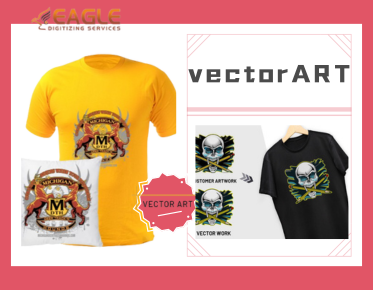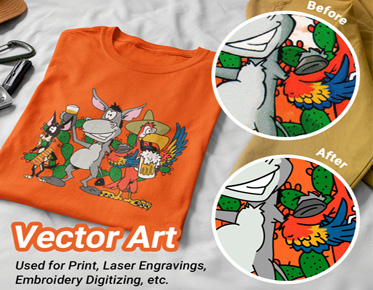From Digital to Fabric: Converting Vector to Embroidery
Embroidery is more than just stitching; it's an art form that bridges the digital and physical worlds. Converting vectorfiles to embroidery opens up a world of creative possibilities, transforming digital designs into tactile masterpieces. Let's explore the journey from screen to stitch and unravel the magic of embroidery conversion.
Why
Convert Vector Files to Embroidery?
Embroidery offers a unique way to bring digital designs to life. By converting vector files, you can create intricately stitched patterns with precision and detail that captivate the eye. Whether for personal projects or commercial ventures, embroidery adds depth and texture to designs, elevating them from flat images to tactile works of art.
Understanding
Vector Files
The Basics of Vector Graphics
Vector graphics are composed of mathematical equations that
define shapes and lines. Unlike raster images made of pixels, vectors maintain
their crispness and clarity when resized. This scalability makes them ideal for
embroidery, where precision is paramount.
Popular Vector Formats: SVG, AI,
EPS
Common vector formats include SVG (Scalable Vector Graphics), AI
(Adobe Illustrator), and EPS (Encapsulated PostScript). Each format has its
strengths, but all share the advantages of scalability and compatibility with
embroidery software.
Why Vectors Work Well for
Embroidery
Embroidery machines interpret designs as a series of stitches, and vectors provide the ideal blueprint for this process. Their clean lines and defined shapes translate seamlessly into stitch patterns, ensuring accurate replication of the original design.
Embroidery
Basics
Embroidery 101: Types and
Techniques
Embroidery encompasses a variety of techniques, from traditional hand
stitching to modern machine embroidery. Each method offers its unique aesthetic
and challenges, but all share the common goal of embellishing fabric with
thread.
The
Art of Hand Stitching: Slow and Deliberate
Hand stitching embodies the essence of craftsmanship, requiring patience, precision, and a keen eye for detail. Each stitch is meticulously placed by hand, creating a tactile and organic texture that imbues the fabric with character and charm. From delicate floral motifs to intricate monograms, hand stitching allows artisans to express their creativity with a personal touch.
The
Rise of Machine Embroidery: Fast and Precise
In contrast to hand stitching, machine embroidery offers speed,
consistency, and precision. With the advent of computerized embroidery
machines, intricate designs can be stitched out quickly and efficiently, making
it ideal for mass production and commercial applications. From intricate logos
on apparel to intricate designs on home decor items, machine embroidery has
revolutionized the world of textile embellishment.
Understanding Embroidery File
Formats
Embroidery files come in various formats, such as DST, PES, and EXP.
These formats contain instructions for the embroidery machine, specifying
stitch types, colors, and sequencing. Choosing the right format is essential
for compatibility with your machine.
The Role of Digitizing in
Embroidery
Digitization is the conversion of artwork into embroidery files. It involves translating design elements into stitch data, taking into account factors like stitch density, underlay, and pull compensation. Skilled digitizers play a crucial role in ensuring the fidelity and quality of embroidered designs.
Tools
of the Trade
Choosing the Right Software for
Conversion
Embroidery software offers a range of features for digitizing vector
files. Popular programs like Wilcom Embroidery Studio and Hatch
Embroidery provide intuitive interfaces and powerful tools for precise
digitization.
Top Embroidery Digitizing
Programs
Digitizing programs vary in complexity and price, catering to
beginners and experienced professionals alike. Explore options like
Embrilliance Essentials and Bernina Embroidery Software to find the best fit
for your needs and budget.
Hardware Essentials: Embroidery
Machines and Accessories
Investing in a quality embroidery machine is essential for bringing your designs to life. Consider factors like hoop size, stitch speed, and additional features when selecting a machine. Accessories like stabilizers, needles, and thread are also crucial for achieving optimal results.
Preparing
Your Vector File
Cleaning Up Your Vector Design
Before digitizing, it's essential to
clean up your vector design to remove any unnecessary elements or
imperfections. Simplify complex shapes, consolidate overlapping paths, and
ensure smooth curves for optimal stitch quality.
Simplifying Complex Designs for
Stitching
Complex designs may need to be simplified for embroidery, especially
when dealing with intricate details or small text. Focus on retaining the
essential elements of the design while eliminating unnecessary complexity to
ensure “stitchability”.
Color Considerations: From
Digital to Thread
Embroidery threads come in a vast array of colors, but their palette may differ from digital colors. Consider how colors will translate from screen to thread and make adjustments as needed to maintain the integrity of the design.
The
Conversion Process
Step-by-Step Guide to Digitizing
Your Vector
Digitizing a vector design involves several steps, from importing the
file into embroidery software to fine-tuning stitch parameters. Follow a
systematic approach to ensure accuracy and quality throughout the digitization
process.
Setting Up Your Embroidery
Software
Configure your embroidery software settings to match your machine and
project requirements. Adjust parameters such as stitch length, density, and
underlay to achieve the desired stitch quality and appearance.
Importing and Adjusting Your Vector File
Import your vector file into the embroidery software and adjust its
size, position, and orientation as needed. Use tools like node editing and path
manipulation to refine the design for optimal stitchability.
Digitizing Techniques
Mastering digitizing techniques is essential for creating high-quality
embroidery designs. Learn about different stitch types, such as fill stitches,
satin stitches, and running stitches, and how to use them effectively to
replicate the original artwork.
Understanding Stitch Types: Fill,
Satin, and More
Each stitch type has its characteristics and applications in
embroidery. Fill stitches are used to cover large areas, satin stitches create
smooth, shiny surfaces, and running stitches add texture and definition.
Experiment with stitch types to achieve the desired visual effect.
Layering Stitches for Depth and
Texture
Layering stitches can add depth and texture to embroidery designs,
enhancing their visual appeal. Experiment with stitch densities, angles, and
colors to create dynamic effects that mimic the richness of traditional hand
embroidery.
Adjusting Stitch Density for
Best Results
Stitch density plays a crucial role in the appearance and durability
of embroidered designs. Too-dense stitches can cause fabric puckering, while
too-sparse stitches may result in insufficient coverage. Fine-tune stitch
density settings to achieve optimal results for your specific project.
Handling Text and Small Details
Text and small details require special attention during digitization to ensure legibility and clarity. Use appropriate stitch types and densities to maintain the integrity of text and fine lines, and consider enlarging or simplifying intricate details for better stitchability.
Troubleshooting
Common Issues
Common Conversion Problems and
Solutions
Embroidery digitizing can pose various challenges, from thread breaks
to misalignment. Troubleshoot common issues like thread tension, needle
selection, and design complexity to achieve consistent and professional
results.
Avoiding Puckering and
Distortion
Puckering and distortion are common problems in embroidery, especially
on lightweight or stretchy fabrics. Use proper stabilizers, hoop tension, and needle
types to minimize distortion and ensure smooth, flat stitching.
Testing and Tweaking Your Design
Test your embroidery design on scrap fabric before stitching it onto
your final project. Evaluate stitch quality, density, and color accuracy, and
make any necessary adjustments to the design or settings to address any issues.
Preparing for the First Stitch-Out
Before stitching your design on the final fabric, prepare your
embroidery machine by threading the needle, selecting the appropriate thread
colors, and securing the fabric in the hoop. Perform a trial run to ensure
everything is set up correctly before proceeding with the final stitch-out.
Creating a Test Embroidery
A test embroidery allows you to evaluate the quality of your design
and make any final adjustments before stitching it onto your final project. Use
scrap fabric and thread to create a test sample that closely resembles the
final fabric and thread colors.
Making Final Adjustments Based
on Test Results
Based on the results of your test embroidery, fine-tune your design or settings to address any issues or improve stitch quality. Pay attention to details like thread tension, stitch density, and color blending to achieve professional results.
Finalizing
Your Embroidery File
Exporting in the Right Format
Once you're satisfied with your embroidery design, export it in the
appropriate format for your embroidery machine. Common formats include DST,
PES, and EXP, but consult your machine's manual for compatibility and
requirements.
Transferring Files to Your
Embroidery Machine
Transfer your embroidery files to your embroidery machine using a USB drive, memory card, or direct connection. Follow the instructions provided by your machine's manufacturer to ensure seamless file transfer and compatibility.
Embroidery
Techniques for Different Fabrics
Adapting Your Design for Various
Materials
Different fabrics require different embroidery techniques to achieve
optimal results. Consider factors like fabric weight, stretchiness, and texture
when digitizing your design, and adjust stitch settings accordingly to ensure
compatibility and durability.
Stabilizers and Their Importance
Stabilizers play a crucial role in embroidery by providing support and preventing fabric distortion during stitching. Choose the right stabilizer for your fabric type and project requirements, and use multiple layers or specialty stabilizers as needed for added stability and reinforcement.
Adding
Creative Touches
Incorporating Appliqué and Special
Effects
Appliqué is a versatile embroidery technique that involves layering
fabric pieces onto a base fabric and stitching them in place. Explore appliqué
designs and techniques to add dimension, texture, and visual interest to your
embroidered creations.
Using Variegated and Metallic
Threads
Variegated and metallic threads add depth, dimension, and shimmer to embroidery designs. Experiment with different thread types, colors, and textures to create unique and eye-catching effects that enhance your embroidered creations.
Successful
Conversions
Examples of Well-Executed
Embroidery Designs
Study examples of successful embroidery designs to gain inspiration
and insights into effective digitization techniques and stitch applications.
Analyze the use of color, texture, and stitch density to understand how these
elements contribute to the overall impact of the design.
Lessons Learned from Real-Life
Projects
Real-life embroidery projects provide valuable lessons and practical knowledge that can inform your own digitization and stitching endeavors. Reflect on challenges faced, solutions implemented, and outcomes achieved to improve your skills and techniques.
Tips
for Professional Results
Best Practices for High-Quality
Embroidery
Follow best practices for achieving professional embroidery results,
from proper design preparation and digitization to careful stitching and
finishing. Pay attention to detail, practice precision, and maintain
consistency throughout the digitization and stitching process.
Maintaining Consistency Across
Multiple Items
Consistency is key in embroidery, especially when producing multiple items or replicating designs across various products. Standardize your digitization settings, thread colors, and stitching techniques to ensure uniformity and quality across all embroidered items.
Bringing
Your Digital Art to Life: Final Thoughts
Embroidery conversion is a fascinating journey that transforms digital designs into tangible works of art. By mastering the digitizationprocess, exploring creative techniques, and honing your stitching skills, you can breathe life into your digital art and create stunning embroidered masterpieces.
Embark on your embroidery journey with confidence and enthusiasm,
knowing that each stitch brings you closer to mastery. Practice digitization
techniques, experiment with stitching styles, and challenge yourself with new
projects to refine your skills and unleash your creativity in embroidery.



